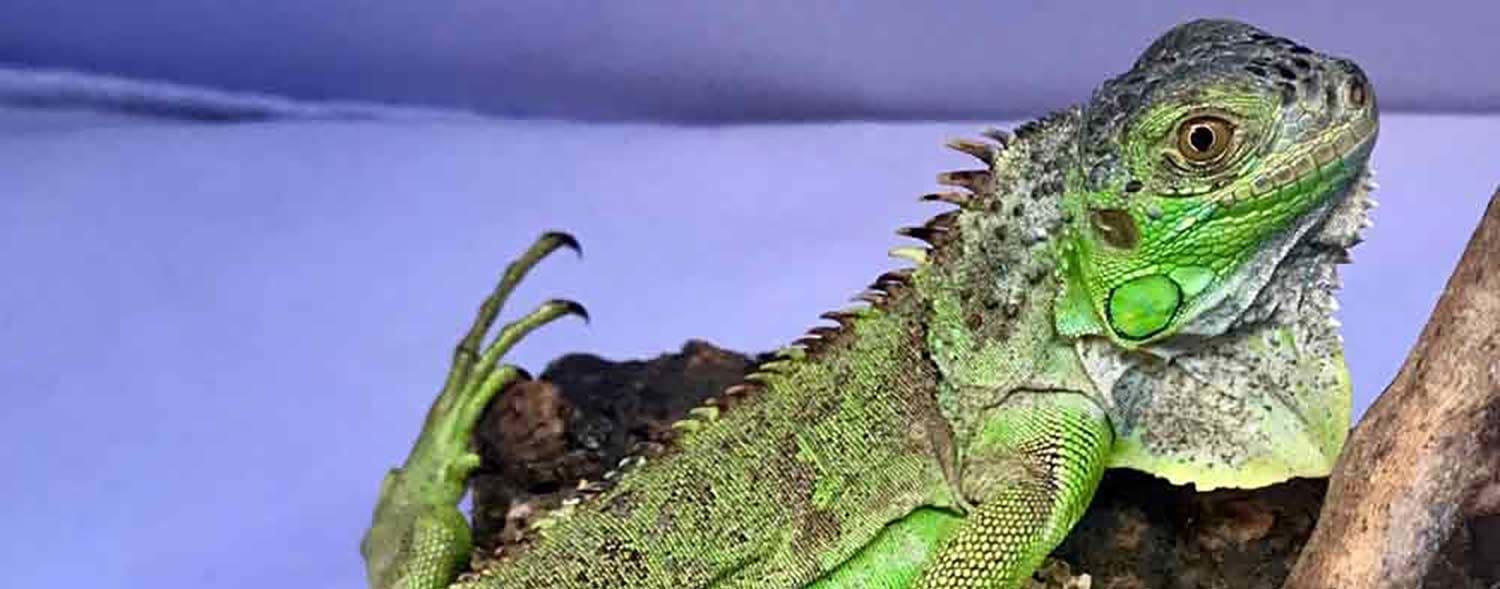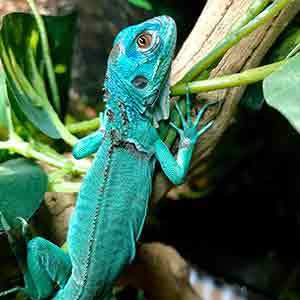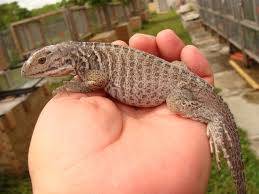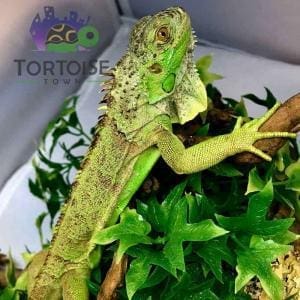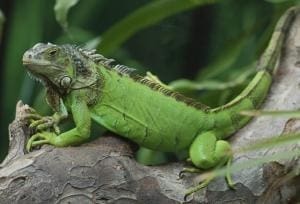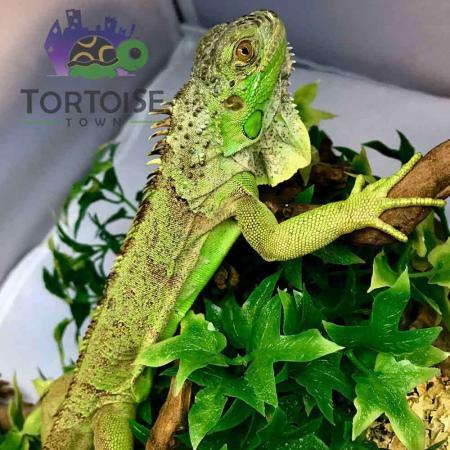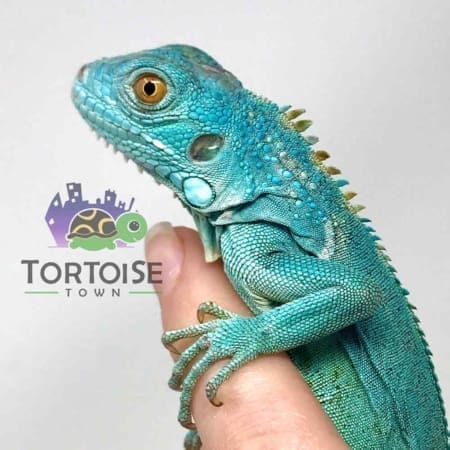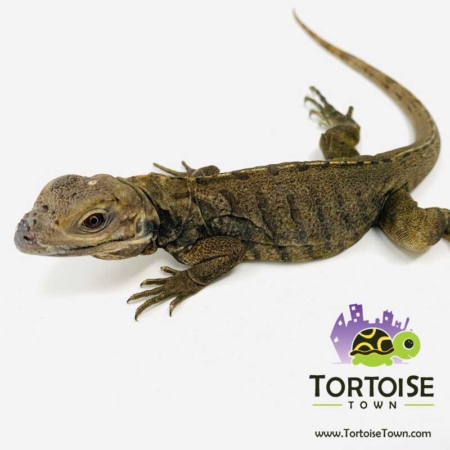Iguana Diet & Iguana Food List
As pet iguanas, iguanas should be on a mostly vegetarian diet. Vegetarian Iguana diets ensure they can live a long live and prevents issues from arising related to their kidneys. Therefore try to feed your iguana mostly vegetables, greens, flowers and even some fruits.
Do not feed your pet iguana any type of insects, eggs, cheese, dog food and more. Years ago, keepers used to give iguanas meat or bugs to make them grow bigger, especially at a younger age. By offering this type of diet, iguanas will end up dying slowly of kidney failure so stay far away from meat and proteins.
Any form of the protein that your iguana needs should come from vegetables. Iguanas also don’t drink much water – so they also get most of the moisture from the food. For this reason stear clear of dog or cat foods as they have un-natrural amounts of protein and limited moisture content, especially if dry. You may supplement with some softened mazuri tortoise and iguana diet, soaked in water until softened.
Greens are the key to healthy iguana diets
Your iguana must mainly eat leafy greens – you should offer them every day. Then, with less frequency, you can add other veggies and flowers.
Leafy greens should make up 50-60% of iguana’s diet. Then, 30-40% will contribute to vegetables and flowers. Fruits and berries should only contribute to 10% of your iguana’s diet.
Each day here at TT we mix various staples foods into our iguana salad. From time to time you can add a little bit of fruits to the salad as well. We recommend mix ing at least 4-5 types of greens (65%), 1-2 types of veggies (25%), and few pieces of fruit that is iguana safe (see our food lists) (10%).Don’t forget to alternate the types of veggies, types of greens, flowers and fruits daily. This will provide varied nutrition and elminate the possibility of being nutrient difficient.
Go easy on the fruits for iguanas
Even if the fruit is in the staple food list, you must only offer 10% of fruits in iguana’s diet! Same goes to vegetables – 30-40%! Offer greens every day, and mix some staple or occasional veggies, fruits and flowers in the salads! Quantity and frequency is the key.
Iguana Water
Always provide your baby and adult iguana with fresh, clean water. We recommend using filtered water. If you are using tap “city water” it is a good idea to let it sit for 36-48 hours so the chlorine evaporates and it is safer for them to drink. Using clean well water normally allows you to skip this step and is readily drinkable. Iguanas need water available all the time, even though they get most of their water thru their diet. This is also why feeding a high quality diet of fresh greens is important, because of the water content.
Best foods for iguanas
- Dandelion greens – both flowers and leaves of the dandelion plant
- Collard greens are GREAT
- Hibiscus (flowers and greens mix in with iguana salad)
- Snap beans or snap peas
- Turnip greens (offer at least every other day)
- Escarole is great as well
- Mustard greens and kale
- Squash (grated spaghetti squash, butternut, yellow, Hubbard, gem, Kabocha, acorn).
- Watercress
- Endive Greens
- Parsnips
- Alfalfa
Iguana Care Guide
Pet Iguanas for sale are some of the most popular pet lizards for sale in the world. Whether it be a blue iguana for sale, green iguana for sale, or even a beautiful baby Rhino Iguana, keeping iguanas is fun if you are properly prepared. Guiding you thru owning an iguana is our wonderful iguana care guide. Our biologist has written our iguana care sheet with the beginner reptile keeper in mind.
Owning a baby iguana for sale is a big step in the reptile world. Sure, your new iguana is small and cute, but not for long! Depending on the species of pet iguana you purchase, it can be large and in charge in no time without proper keeping and handling. A Rhino iguana for sale is one of the largest species of iguana kept as pets. Rhinos are super smart and “dog like” in personality once tame.
Our full iguana care guide provided by our staff biologist provides detailed information on the following topics:
- Iguana Care sheet
- Iguana diet
- Pet Iguanas for sale
- Iguana Humidity
- Iguana Light UVB
- Iguana habitat temperature
- Caging and Iguana Habitat
- baby and adult Iguana Size
- Iguana Lifespan
- Iguana Water
- Pet Iguana Size
- Handing Iguanas
- iguanas for sale
- blue Iguana for sale
- green Iguana for sale
- rhino Iguana for sale
- red Iguana for sale
- baby iguana
Iguana UVB Lighting
Most keepers provide the iguana both heat and light thru the same element. Keeping a heat lamp and a UVB lamp is also ok, and normally used in larger setups. A Basking lamp is great, but does it produce enough UVB as well as UVA? Using a UVB Tube in addition to a mercury vapor basking lamp will ensure you are completely covered regarding lighting. Iguana care sheets should always have an in-depth look at the important of UVB lighting for both heat and light exposure purposes. No matter the color iguana, whether it be a blue iguana for sale, or rhino iguana for sale, UVB is super important.
UVB Iguana lights for Vitamin D3
Keep in mind that UVB helps Iguanas synthesize vitamin D3, which is needed to help metabolize calcium in your new baby Iguana’s diet. No Iguanas cannot process the vitamin D3, therefore they require a strong UVB lamp to help their bodies produce and metabolize Vitamin D3. Without a UVB source and Vitamin D3, Iguanas will be unable to process calcium properly. If you are not providing correct lighting your new baby iguana will be susceptible to Metabolic Bone Disease, an often fatal result of calcium deficiency coupled with lack of proper lighting. Consider UVB lighting one of the most important parts of an iguana care guide.
Types of UVB Lamps for Iguanas
Using a tube style UVB lamp will cover more than just a basking area as it should. Providing a tub UVB lamp will provide a great gradient for your Iguana to move in and out of. This will enable your baby iguana for sale to get different amounts of UVA and UVB. We recommend a 10% or 10.0 lamp, if mounted 18″ from the ground. Using a T5 HO fixture is recommended. You can purchase them direct on our website. Also, always remember to replace your UVB bulbs and basking lamps at least every 6 months.
Different brands of UVB Iguana lights produce different results
Several types of UVB producing bulbs are on the reptile and iguana UVB lighting market. Some of the best include ZooMed’s Iguana Light 5.0 and Reptisun 5.0, as well as T-Rex’s Active UVHeat bulb and ZooMed’s PowerSun to name a few. The first two are fluorescent-style tube bulbs that require a special fixture. The second two are mercury vapor lights that produce both heat and UVB. While not as good as tube style lamps, these fit in a regular dome light socket, but produce a lot of heat and require a ceramic socket.
While much better than screw in bulbs, most tube-style UVB bulbs lose their UVB in 6-10 months, even though they still produce visible light. The Active UVHeat bulbs last at least a year, and provide heat as well as the some of the needed UVB. For this reason we recommend using both a MVB and a T5 tube light to provide your iguana UVB.
Distance of UVB light from your Iguana
UVB dissipates with distance and can be metered as such using a Solar meter. Be sure your iguana is able to get close enough to the UVB lighting for it to be effective. Mercury vapor lamps should be 12-18″ away where as T8 can be 10-12″ and T5 15-24″ depending on if you are using a 10% or 12% uvb lamp.
Buying the right UVB lamp for your pet iguana
Be careful when shopping for a UVB bulb. Many manufacturers advertise their bulbs as ‘full spectrum’ even though they do not produce UVB. Make sure you purchase a bulb that specifies UVB production. The bulb should state that it produces at least 5% UVB. Read the packaging carefully.
Several people have had problems buying lights that state they produce UVB (especially the new coil style UVB lights) but they do not produce enough UVB to keep the iguana healthy. Many of these people are now treating their iguanas for MBD (metabolic bown disease). Grow Lights, lights made for aquariums, and plant lights are NOT UVB producing lights and may emitt light, but not the UVB needed by your iggy.
Be Careful not to block UVB light
Be aware that UVB can be ‘diluted’ or blocked by many things. Lastly, use common sense. UVB rays cannot pass through glass, and if they do, it cuts down on the output significantly. The same thing applies to plastic and plexiglas. Make sure that your iggy can get direct UVB lighting without anything blocking it. Also, as you would think, screens and mesh can also block or filter UVB rays. Last but not least, when planning your iguana habitat setup, try to find the larger sized mesh available. With proper understanding, providing the right UVB Light for your new baby iguana for sale can be easy, and rewarding.
Iguana Lifespan
Well cared for pet iguanas may have a lifespan of approximately 10-15 years
Iguana for sale – Size
Most species of pet iguanas for sale end up being around the same size. A baby iguana can be anywhere from 10-16″ where as a juvenile is closer to 24-36″. Adult iguanas can get as large as 7 ft in total length, including the tail. Most however, fall in the 5-6″ range inclusive of their tails. This is why buying an iguana from the right iguana breeder, who handles their baby iguanas for sale early and often is so important. Here at TT we handle our baby iggies as much as possible to ensure calm and even tempered pet iguanas for sale.
Iguana Habitat
When it comes to the size of your new pet iguanas habitat, the bigger the better. Basically go with the largest sized iguana setup you can build or buy. Also, consider the largest you can fit as well. So the biggest that you can fit and largest you can afford is the best option. We offer a full line of iguana cages for sale, that with the right lighting, heating, and substrate can make fantastic iguana habitats.
Consider that your once tiny pet iguana for sale will one day grow. When your Iggy grows to 3-4 feet, he or she will need some space to unwind and relax and enjoy a happy lifestyle. Consider that you could make a killer looking habitat for little money with the right plants, fake or live trees, vines and the like. Controlling humidity can be done with a reptile fogger like the one we sell here at TT.
Iguana Care Guide – Iguana Habitats for sale
Iguana habitats for sale are often also marked or sold as chameleon habitats. We recommend the large Reptibreeze iguana habitat. The XL size is 4x2x2 ft in overall size. Using the larger will enable your iguana to both bask and cool properly as the larger environment lends to a larger thermal gradient. Thermal gradients are important for all reptiles which use the cool and hot areas of their environment to regulate body temperature.
Iguana Temperature
For both baby and adult iguanas for sale, keep your temperatures between 75 and 92 degrees. A Basking area of 89-95 should be provided during the daylight hours. If your home or area your habitat is kept gets cool at night, you may need to add some alternative nighttime heating to your iguana habitat setup. Normally providing a UVA/UVB Basking lamp is sufficient, but again keep in mind where you keep your habitat beings indoor etc. If you are keeping your setup outdoors, be sure you live in the right climate to keep a pet iguana outdoors in. We recommend using a basking lamp as well as a t5 high output UVB lamp for any pet iguana for sale.
Remember, like all reptiles, Iguanas are ectothermic, meaning that they rely on their environment to regulate their temperature. For this reason, Iguanas require a higher temperature in their enclosures. Try to dial in your setup with a basking spot 95°F to 100°F. The cooler end of the cage 80°F to 85°F.
Pet Iguana for sale | Humidity
Baby and Adult Iguanas also need high humidity in their cage. Humidity for all iguanas should be kept at around 75% . Looking for how to increase humidity? Easy! You can increase the humidity of the iguana habitat by providing your iguana with a large pool of water, or by purchasing a mister or reptile fogger for sale. You should mist your baby iguana at least twice a day to increase the humidity and to promote proper shedding and overall skin health.
Handling a Pet Iguana
Handling Iguana owners should learn to read their pet’s body language because it can provide hints as to whether the iguana is friendly or is about to attack. Iguanas use their tails as their first line of defense when they feel threatened. When handing a baby iguana, take the time to “scoop it up” by placing your one hand under its’ abdomen. Carefully use your other hand to gently nudge the iguana onto your lowered hand. Try your best to not make them feel like they are being “picked up”. Rather have them feel as if they are walking onto your hand willingly. The more often you handle your baby iguana for sale, the tamer he or she will become as you build trust.
How to avoid being tail whipped before your Iggy is tame!
When handling an iguana, you should always be cognizant of where its tail is, so that you can avoid being struck. Iguanas should be held with two hands; it is useful to support their body weight with one palm under the belly and to use your other hand to secure the shoulders and neck. In this position, you can tuck your iguana’s tail under the arm that is supporting its body, so that the tail is held securely against you.
Remember, scared or untame Iguanas can bite and have strong jaws and sharp teeth that they may use if frightened. When you are new to handling your iguana, be sure to avoid putting your hand near his or her mouth. Iguanas can bite, and do have teeth. While it is rare, a scared Iggy can be dangerous for those who do not respect it or know how to properly handle it. Also, iguanas have long fingers and claws that help them to climb. For this reason, your new pet iguana may accidentally scratch you if allowed to climb on or around you. Putting in the time is worth while. For those that are handled often, most baby iguanas become very tame and friendly with their owners.
Pet Iguana Diet
As pet iguanas, iguanas should be on a mostly vegetarian diet. Vegetarian Iguana diets ensure they can live a long live and prevents issues from arising related to their kidneys. Therefore try to feed your iguana mostly vegetables, greens, flowers and even some fruits.
Do not feed your pet iguana any type of insects, eggs, cheese, dog food and more. Years ago, keepers used to give iguanas meat or bugs to make them grow bigger, especially at a younger age. By offering this type of diet, iguanas will end up dying slowly of kidney failure so stay far away from meat and proteins.
Any form of the protein that your iguana needs should come from vegetables. Iguanas also don’t drink much water – so they also get most of the moisture from the food. For this reason stear clear of dog or cat foods as they have un-natrural amounts of protein and limited moisture content, especially if dry. You may supplement with some softened mazuri tortoise and iguana diet, soaked in water until softened.
Greens are the key to healthy iguana diets
Your iguana must mainly eat leafy greens – you should offer them every day. Then, with less frequency, you can add other veggies and flowers.
Leafy greens should make up 50-60% of iguana’s diet. Then, 30-40% will contribute to vegetables and flowers. Fruits and berries should only contribute to 10% of your iguana’s diet.
Each day here at TT we mix various staples foods into our iguana salad. From time to time you can add a little bit of fruits to the salad as well. We recommend mix ing at least 4-5 types of greens (65%), 1-2 types of veggies (25%), and few pieces of fruit that is iguana safe (see our food lists) (10%).Don’t forget to alternate the types of veggies, types of greens, flowers and fruits daily. This will provide varied nutrition and elminate the possibility of being nutrient difficient.
Go easy on the fruits for iguanas
Even if the fruit is in the staple food list, you must only offer 10% of fruits in iguana’s diet! Same goes to vegetables – 30-40%! Offer greens every day, and mix some staple or occasional veggies, fruits and flowers in the salads! Quantity and frequency is the key.
Iguana Water
Always provide your baby and adult iguana with fresh, clean water. We recommend using filtered water. If you are using tap “city water” it is a good idea to let it sit for 36-48 hours so the chlorine evaporates and it is safer for them to drink. Using clean well water normally allows you to skip this step and is readily drinkable. Iguanas need water available all the time, even though they get most of their water thru their diet. This is also why feeding a high quality diet of fresh greens is important, because of the water content.
Best foods for iguanas
- Dandelion greens – both flowers and leaves of the dandelion plant
- Collard greens are GREAT
- Hibiscus (flowers and greens mix in with iguana salad)
- Snap beans or snap peas
- Turnip greens (offer at least every other day)
- Escarole is great as well
- Mustard greens and kale
- Squash (grated spaghetti squash, butternut, yellow, Hubbard, gem, Kabocha, acorn).
- Watercress
- Endive Greens
- Parsnips
- Alfalfa
- Display 21 Products per page

